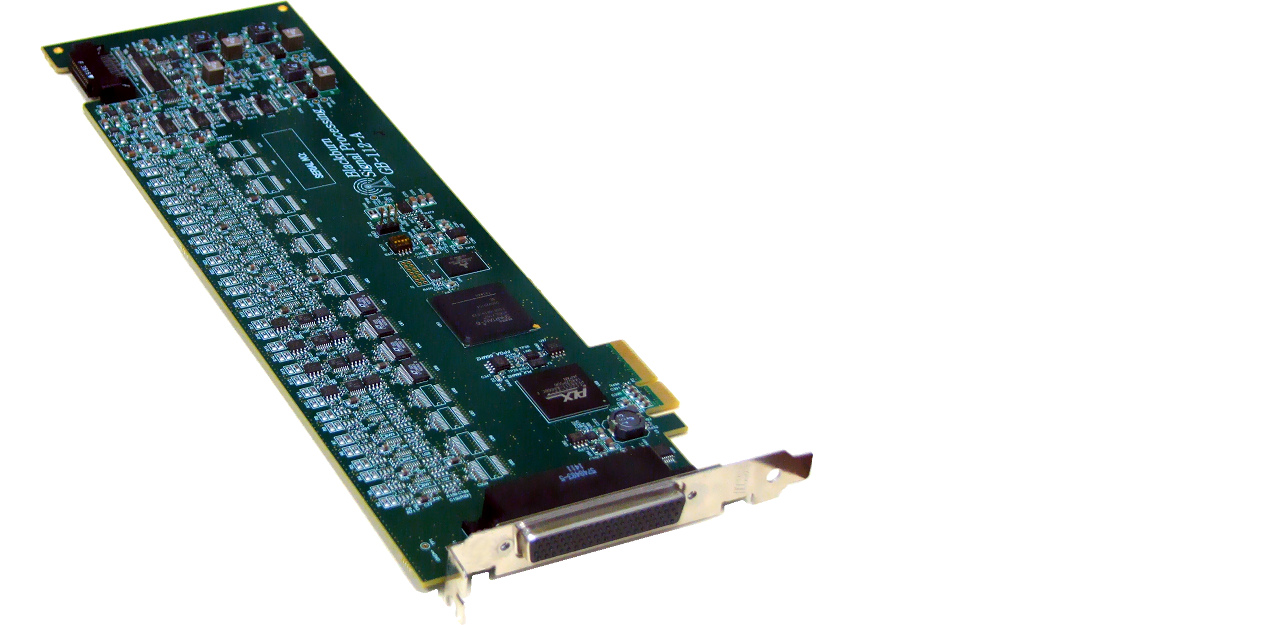
GB112: 32 channel acoustic DAC for PCIe systems
- PCI Express form factor with 32 analog output channels. Dual DRAM banks, 512MB total storage. 16 bit resolution DACs.
- Programmable DAC sample rate: 10KSPS to 1MSPS. Sampling frequency accurate to less than 1Hz.
- Precise synchronization and phase coherent operation between multiple cards.
- Software Development Kit (SDK) for Windows and Linux.
Product Description
To achieve high resolution imaging, and precisely locate targets, sonar systems need to accurately generate many signals synchronously. Active systems concentrate transmit power by beamforming horizontally, vertically, or both. This requires precise phase control of the individual transmit signals that are optimized for the hydrophone array geometry. Although commercial audio DAC components are capable of generating signals suitable for deep water and large targets, many modern sonar missions involve detection of small targets such as mines and scuba divers, often in shallow water along coastlines or in harbour. These conditions require the ability to generate pings or chirps at frequencies far in excess of 100 kHz. Any signal generator intended for high frequency sonar systems must be able to generate phase coherent versions of these waveforms across many channels, with exceptional phase and amplitude control. A high oversampling ratio is mandatory, as this allows accurate generation of complex waveforms, and simplifies reconstruction filtering by locating signal images far from the fundamentals. Based on these requirements, Blackburn Signal Processing developed the GB112 acoustic signal generator. This full length PCI Express slot card adds up to 32 channels of high frequency acoustic signal generation capability to desktop PC’s or servers, allowing them to be deployed in a wide variety of shipboard or shoreline sonar applications.
Frequency domain characteristics
The GB112 allows the user to generate signal frequencies much higher than commercially available Sigma Delta DACs, but with the benefits of high oversampling ratios (32x to 256x) normally associated with those devices. The host system provides waveform data at the baseband rate, up to 1 MS/sec per channel. An FPGA based interpolation engine then upsamples and filters the waveform data, providing output data streams at up to 32MS/sec per channel. This processing generates signals with Sigma Delta like frequency domain characteristics. Signal images are usually over 5 octaves away, the two pole reconstruction filtering included on the card is usually the only analog signal conditioning required before driving external devices.
Time domain
In addition to providing excellent frequency domain characteristics, the GB112 enables time domain performance enhancements through different transmit modes. Signals may be generated in pulsed, loop, or streaming mode. Pulsed waveforms typically allow improvements in range resolution, particularly when modulated pulses are used with pulse compression algorithms in the receiver. In pulsed mode a specific number of samples are converted following a trigger event, after which conversion stops. The card will accept a fresh data set while converting an existing one, but re-transmission of an existing data set is permitted as well as . In loop mode, a set of periodic data is written to the card once, and then repetitively converted to analog waveforms. This mode is ideal for generation of waveforms such as FMCW, a situation where the data set is not likely to be updated regularly. Streaming mode is intended for playback of large quantities of data, such as when playing back an archive of recorded signals, or when simulating signals during simulation, or operator training.